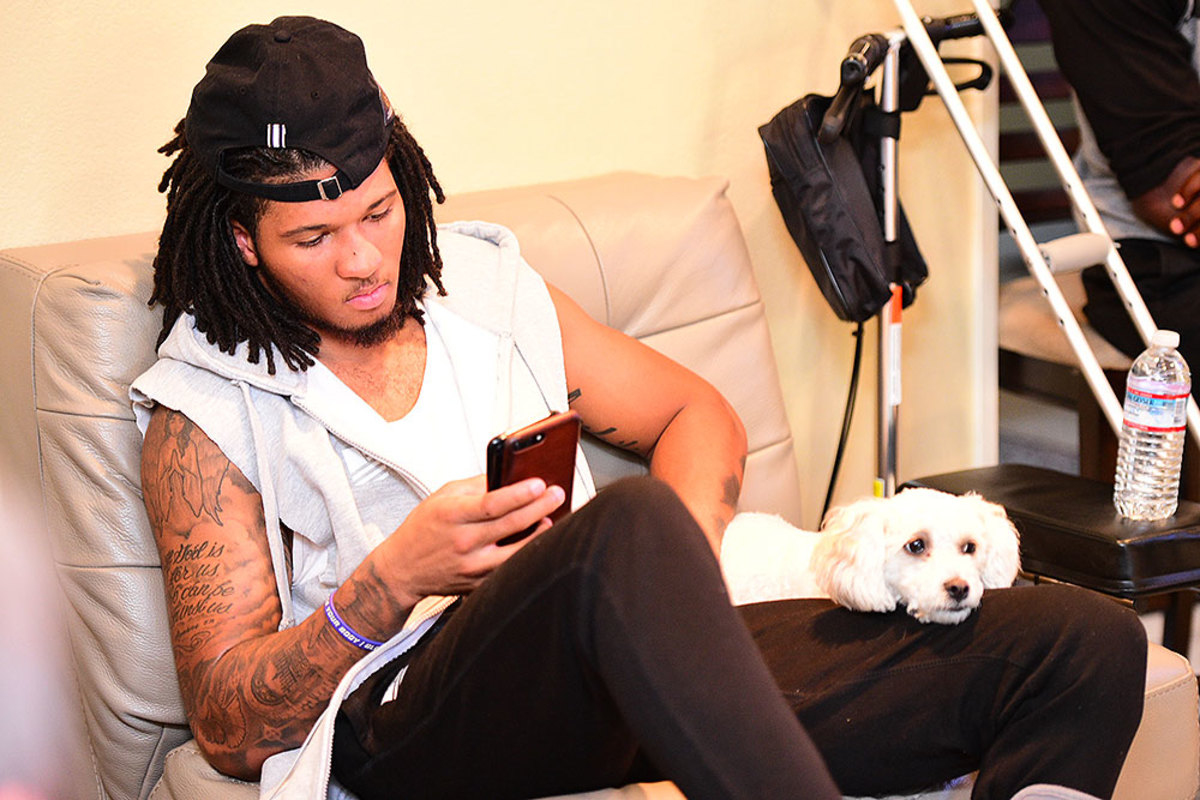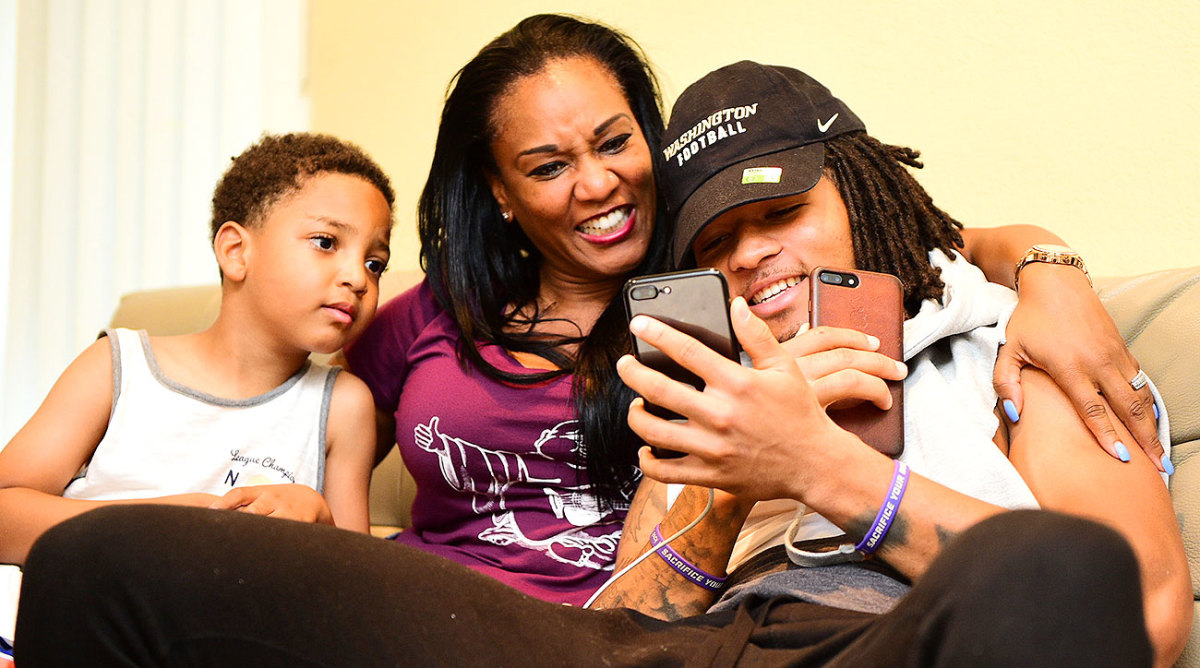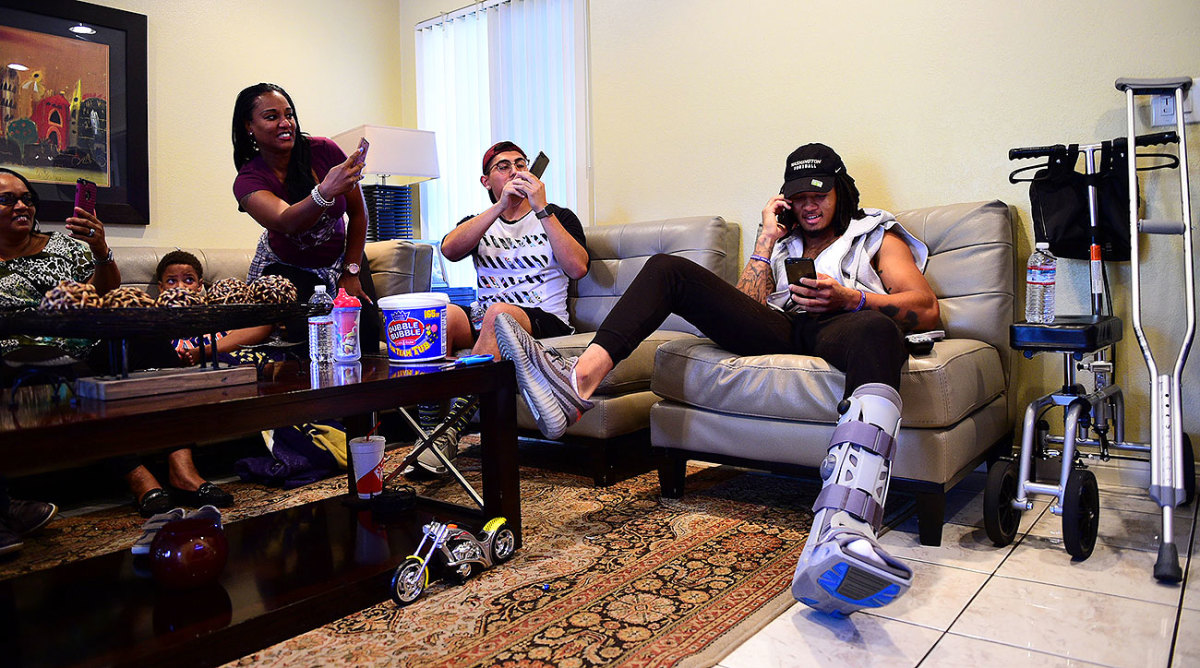The waiting game: An injury forced Sidney Jones to sweat out the draft from his couch

Five picks into the 2017 NFL draft, Sidney Jones pulls into the driveway of his childhood home in Diamond Bar, Calif., 28 miles east of downtown L.A. He leans his six-foot, 186-pound frame on the crutch under his left arm and hops on one leg into the living room, where his extended family grazes on pizza, already fully occupying two couches.
Jones started three seasons at cornerback for Washington, earning first-team All–Pac‑12 accolades the last two. He announced his early departure in January, as some scouts named him the best cornerback in the draft. That was months ago. The draft is here now; it’s an event more than 20 years in the making for Jones. And all he can do tonight is wait.
One hour in, Jones is reclining on a gray leather couch, wearing a black shirt, his dreadlocks spilling out of a Yankees cap, his head propped up on a brown throw pillow, his left leg sheathed in a brace. He proves more adept at mock drafts than most experts, correctly predicting four selections between picks eight and 14.
One of those draftees is Jones’s college teammate John Ross, a wideout with Sonic the Hedgehog speed. The Bengals take him at No. 9 and Jones pumps a fist as Ross hugs commissioner Roger Goodell onstage. Ross is one of two Huskies at the event outside the Philadelphia Museum of Art; there’s also cornerback Kevin King, who, along with safety Budda Baker and Jones, gave the Washington secondary three NFL hopefuls. Two months ago Jones might have joined his brothers in the City of Brotherly Love. Two months ago the Eagles strongly implied they would take him with their first-round pick, at No. 14. Instead tonight they use it on Derek Barnett, a defensive end from Tennessee.
How Kevin King, the hidden gem of an NFL-bound secondary, became a draft late riser
Four picks later, the Titans are on the clock at No. 18. They need help at corner, and Jones says he got a “good vibe” from them at the NFL combine in Indianapolis, in March. He has two phones nearby, both charging: his regular phone, which buzzes constantly with texts and social media notifications; and another strictly for NFL business.
“Who they got, Sid?” asks Jones’s grandfather, Charles Watson.
“How about Sidney Jones?” interrupts Sidney’s mother, LaKeysha Pugh.
“He’s right here,” says Chance, Jones’s four-year-old brother, as he fiddles with a green lightsaber, “but he can’t walk.”
“He’ll come back a beast,” says Watson.
Sidney doesn’t look up. He fiddles with both phones. Tennessee selects USC’s Adoree’ Jackson, the third cornerback off the board this evening.
“They’re all going to be sorry,” LaKeysha says.
As the draft seeps into a fourth hour, Sidney mounts a black scooter and wheels back to his bedroom, where he’ll consult with his agent, Doug Hendrickson, on the NFL phone. Jones had told his mother last week that he didn’t want a lot of people coming by. “I’m just going to get a phone call, Mom,” he grumbled.
Not tonight. The first round finishes without a buzz. Five cornerbacks are gone. But Jones appears unfazed. He has been through worse.

Day One spills into Day Two and the living room is crowded now: Sidney’s grandparents, his brother, mother and her boyfriend, plus three childhood friends. Every-one grows anxious as a call comes from Hendrickson. Sidney nods. “Any word?” Nod. “All right.” Another nod. “Yup.” Again. “Sounds good.” The room waits for an update as Jones hangs up.
“That wasn’t the call,” he says.
Analysts are predicting a run of defensive backs early in the second round and, sure enough, King, Washington’s second-best corner, is plucked right off the bat, by the Packers at No. 33. Chance runs around the living room, screaming “Huskies!” Zyha, the family’s fluffy white Maltese-poodle mix, is barking. The TV signal cuts in and out, heightening the tension.
The Cardinals take Baker, one more Husky, at No. 36 and ESPN cuts to Baker’s living room. Another family is celebrating.
2017 NFL draft grades: Final analysis of all 32 teams
Almost five hours of draft coverage have passed and Jones has seen the same commercial for ESPN’s First Take 937 times. He’s heard the crowd boo Goodell, over and over, as if the commish cut off its cheesesteak supply. Jones has eaten pizza and fruit and a Chick-fil-A sandwich and he’s run through half a tub of Dubble Bubble gum.
“Sidney is so calm, so cool,” says his mother, who is neither.
“He always is,” says his grandmother, Helen Watson.
Just then, the NFL phone rings.
Washington’s pro day on March 11 in Seattle unfolded in front of 50-odd NFL personnel types. But after all the standard drills, before everyone parted, a representative from the Bengals approached the Huskies’ defensive backs coach, Jimmy Lake, and asked, “Can you have them run that last one once more?”
LaKeysha watched the TV feed back at the house in Diamond Bar and saw her son return to the field. He hadn’t mentioned to her that his left Achilles had been sore for about a week, since the combine in Indy—but it was nothing major, Jones told himself. Push through it.
His grandfather was on the field in Seattle, at the Dempsey Indoor Center, filming on a phone. On the screen he watched as his grandson backpedaled, started to break ... and fell, grabbing his left leg.
It felt, Jones says, like an errant pass had struck him in the ankle. His hand shot to his calf, though he felt no pain.
Inside the Bears’ Covert Op to Draft Mitchell Trubisky
Baker, his backfield mate, sprinted to his side. “What are you doing? Get up.” Jones shook his head—he couldn’t. Baker pulled Jones to his feet and UW coach Chris Petersen helped him off the field. A golf cart whisked Jones to the training room, his facial expression blank. When the MRI eventually came back, Jones’s grandfather spoke for everyone: “Oh s---.”
Ten days later, on the same afternoon Jones underwent surgery for a ruptured Achilles, The Seattle Times ran a haunting photo of an injured Jones looking up at Baker. When Baker saw the picture online, the emotion overwhelmed him. “I got sad just looking at it,” he says.
The Bengals’ coach later shot Jones a text message, wishing him well. Jones doesn’t blame anyone, but that doesn’t change the millions of dollars that vanished in an instant. “That’s as heartbreaking an injury as I’ve seen,” says Lake.
Jones, meanwhile, says all the right things, about “freak accidents” and “facing reality,” how he’s only 20, how he’d never suffered a major injury and how “all I lose is money—but I can make that back.” The only thing that he says bothers him is the random people who tell him, You can’t lose what you didn’t yet have. “Easy for them to say,” he sniffs.
None of the positives from this spring mattered anymore. Not the weeks training in Arizona, the pounds lost and muscle gained. Not the 4.47-second 40-yard dash he ran at the combine. Not the 25 formal interviews in Indy and the teams—Buffalo (picking 10th), New Orleans (11th), Arizona (13th) and Philadelphia (14th)—that expressed interest in drafting him early.
Browns, Bears, Chiefs will likely rue the day they let Deshaun Watson fall to Texans
Before the injury the Eagles had Jones believing they would take him. After-ward, their senior director of college scouting, Anthony Patch, who’d been at the pro day, sent a handwritten letter to the house in Diamond Bar: “I know you’ve worked too hard and you will come back stronger and better than ever.”
As Jones recovered from the operation, he binge-watched Making a Murderer. He warned teams they’d be making a mistake if they passed on him and told them, “Don’t forget what I put on film. Film don’t lie. Whoever takes me is getting the best corner in the draft.”
Pro Football Focus, meanwhile, amended its glowing review as Jones plummeted down draft boards. After “excels at playing press man coverage” and “excellent ball skills” and “willing hitter” and “tremendous footwork” they added, “Torn Achilles at pro day will likely force him to miss his rookie season.”

In mid-April, Jones wore a camouflage sweatshirt as he wheeled his black scooter into a pho restaurant in the north Seattle neighborhood of Lake City. Late-afternoon traffic inched by outside in the rain as he ordered the noodle soup with brisket.
The cast had recently come off Jones’s leg, and he was stunned by what he’d found underneath. “It’s crazy how fast [the calf muscle] just disappears,” he said as steam rose off his soup, curling around his dreadlocks. “I was stunned.”
Jones had started range-of-motion exercises while continuing upper-body workouts. He wasn’t going to rush his rehab, but he didn’t agree with PFF’s assessment. He planned to play in 2017, back by mid-October. At the latest.
As the draft approached, Hendrickson conveyed Jones’s optimism to potential suitors. He touted the credentials of Robert Anderson, the respected Charlotte-based orthopedic surgeon who had performed the surgery; he noted how Jones’s Achilles had torn near the top of the tendon, where it tends to heal faster. He pointed to players—retired wideout Steve Smith, Ravens linebacker Terrell Suggs, Broncos receiver Demaryius Thomas, Dolphins pass-rusher Cameron Wake—who’d returned from the same injury in as little as five months.
How the NFL draft affects the fantasy football impact of 2017's top rookies
Slurping noodles from a bowl in Lake City, Jones shook his head recounting it all. The previous three years had been almost perfect. He became a starter in the first month of his freshman season, snagged two interceptions against 17th-ranked Arizona that November and spent the spring in the film room, decamping to Lake’s office so often that teammates started calling him Sidney Lake.
Jones pursued a degree in American Ethnic Studies at UW, but he really majored in game film. He watched four extra sessions every week with Lake and Baker, and his studiousness showed on the field—against No. 17 USC in October 2015, Jones knew the Trojans liked to run screens on third-and-12 or longer, and on one first-quarter snap he raced into the backfield and intercepted a Cody Kessler screen pass thrown five yards behind the line. In all his years of coaching, Lake had never seen anticipation like that. Midway through Jones’s sophomore season, an NFL career already seemed possible.
During his junior year, when he didn’t allow a single touchdown in coverage, it appeared likely. There he was against Stanford, in late September, closing off the edge to bottle up All–Pac-12 running back Christian -McCaffrey, and throwing around tight ends who outweighed him by 70 pounds, as the Huskies blew out the No. 7 Cardinal, 44–6. Opponents rarely threw at Jones after that—and when they did, like at Cal on Nov. 5, he intercepted them, twice in Berkeley.
Jones became known for his durability, starting 39 straight games, the last against Alabama in the semifinals of the College Football Playoff. The Huskies stumbled, 24–7, against the Crimson Tide, ending their best season in a quarter-century. Afterward Jones couldn’t hold back his tears in the locker room. He never cries, but on that night he put a white towel over his head and bawled.

Jones answers his phone in the living room in Diamond Bar and pulls a black Huskies hat over his eyes, crying again.
He takes six calls from coaches and execs. His mom runs over and wraps both arms around him as family surrounds them, phones out, capturing the moment.
Over the fifth hour of the draft, Jones had come to think that the 49ers might trade up for him. Hendrickson told him the Colts and Dolphins were also interested. But in the end the 215 area code blinked on the phone.
“Is it Philly?” a friend finally asks.
“It’s Philly!”
Moments later, on the TV, that news becomes official—“With the 53rd pick in the 2017 NFL draft, the Philadelphia Eagles select Sidney Jones, DB, Washington”—and everyone in the living room starts shouting, drowning out the broadcast. (That Jones was actually the 43rd pick fazes no one; it’s just one more wacky detail in a strange two months.) Thousands of exultant fans in Philadelphia scream out the Eagles’ fight song, Fly, Eagles Fly!
Jones says nothing. He sits there, wiping at the tears, shaking his head, wrapped in his mom’s embrace. Zyha jumps in his lap and licks his face. His grandmother grabs a box of tissues. “We’re going to Philly, Zyha!” she says, and the dog barks an affirmative.
Online, someone has discovered an old tweet, posted by Jones years ago:
In case you’re wondering what that deleted Sidney Jones tweet was about… pic.twitter.com/OkXL2Hhnwl
— Matt Mullin (@matt_mullin) April 29, 2017
He’s already endearing himself to Philly fans. His phones buzz. Zyha yaps. Friends shout. Family members debate designs for Eagles tattoos. Sidney poses for pictures, scooter parked to one side, and wonders aloud whether his old jersey number, 26, is available. It’s not.
“Bye, Sidney,” Chance tells his brother.
Their mom shakes her head. “He’s not leaving yet, sweetie.”
Jones’s name is trending on Twitter. He FaceTimes with Baker, shouting into the phone, and exchanges texts with Lake, who saw three members of his secondary go in one 11-pick span of the second round. Two neighbors stop by, then a third, a fourth, a fifth, one wearing Jones’s Washington jersey. Chance throws confetti in the air and they all pump their fists as cars drive by, supporters honking and shouting out their windows. Sidney’s grandfather has already checked the Eagles’ 2017 schedule: They play twice near Los Angeles.
“Have you thought about what an Eagle is?” his mom asks. “Eagles are so strong, and that fits you perfectly.”
Patch, the Philly exec, texts Jones: “When I sent that card, I knew you would be an Eagle. Best days ahead.”
“Full circle,” Jones says as he bites into a chicken sandwich and plays Fly, Eagles Fly! at full volume on his phone. He has big plans to celebrate this evening: He’ll fire up the Xbox, update the rosters on Madden and see himself in the NFL.
Next week, he predicts, he’ll walk without the crutch. Each step he takes he’ll move further from the worst thing that ever happened to him, toward a future that’s no longer a dream. The rehab continues, but the wait is over.
